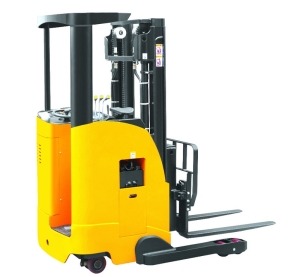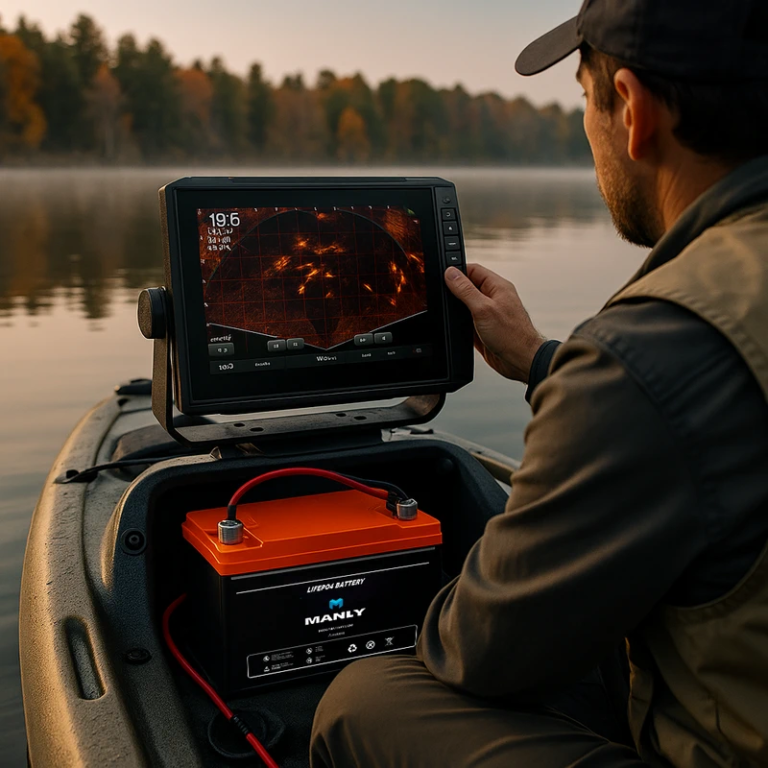Los 28 mejores robots humanoides en 2025
Tabla de contenido
- Los 28 mejores robots humanoides en 2025
- Comprender los robots humanoides: una visión de la evolución robótica
- Las aplicaciones actuales de los robots humanoides en todas las industrias
- Descubre los 26 mejores robots humanoides de 2024
- 1. Ameca: una obra maestra de artes de ingeniería
- 2. Alter 3: La creación colaborativa de la Universidad de Osaka y Mixi
- 3. Armar-6: La maravilla tecnológica del Instituto de Tecnología de Karlsruhe
- 4. Optimus Gen2 de Tesla: Revolución de la robótica humanoide
- 5. Apolo: la avanzada creación humanoide de Apptronik
- 6. Beomni por más allá de la imaginación: redefinir la interacción humano-robot
- 7. Atlas: logro robótico de Boston Dynamics
- 8. Digit: Innovación en movimiento de Agility Robotics
- 9. Jiajia: la Universidad de Ciencias y la Tecnología de China Wonder Wonder
- 10. Erica: Un vistazo al futuro de Hiroshi Ishiguro Laboratories
- 11. Kime: el humanoide de vanguardia de Macco Robotics
- 12. Nadine: robot humano de la Universidad Tecnológica de Nanyang
- 13. Nao: un fenómeno de robótica de SoftBank
- 14. Oceanone de Stanford Robotics Lab: The Underwater Explorer
- 15. Pepper: humanoide amigable de SoftBank Robotics
- 16. Promobot: la cara del servicio al cliente de la nueva era
- 17. Robonaut 2: La colaboración de la NASA y General Motors
- 18. Gracia: Awakening Health Contribution a Robots de cuidado
- 19. Robotespiano: una maravilla teatral de las artes de ingeniería
- 20. Sophia: robot humanoide icónico de Hanson Robotics
- 21. Surena IV: Innovación robótica de la Universidad de Teherán
- 22. T-HR3: Robot humanoide de Toyota para un mañana mejor
- 23. Walker X: el paso de Ubtech Robotics en avanzado robótica
- 24. Phoenix: contribución de Sanctuary AI al mundo humanoide
- 25. Eva: la visión de 1x de la compañera de mañana
- 26. Asimo: robot humanoide pionero de Honda
- 27. Figura 2 Robot humanoide
- Características clave:
- Aplicaciones:
- Robot Humanoide Isaac: una nueva generación de innovación con IA
- Futuro de la robótica humanoide:
- Tendencias y predicciones en el mercado de robots humanoides
- Revelando el futuro: el mundo progresivo de los robots humanoides
- La potencia detrás de los robots humanoides: avances en la tecnología de la batería
- Más información sobre la batería
Comprender los robots humanoides: una visión de la evolución robótica
Humanoid robots, fascinating creations that closely resemble human form and behavior, sit at the exciting crossroads of artificial intelligence, robotics, and human-like attributes. These robots are engineered to mimic real human expressions, interactions, and movements, making them an increasingly vital presence across various industries.The roots of humanoid robotics trace back to the 1960s, with American scientist Joseph Engelberger pioneering the "Three Laws of Robotics." This conceptual foundation laid emphasis on the principles of robot safety and human-robot interactions, igniting interest in the safe development of robots and setting the stage for the evolution of humanoid robots. Since then, leaps in AI and robotics technology have significantly transformed these robots, enhancing their appearance and capabilities.Today's humanoid robots are equipped with sophisticated technologies such as cameras, sensors, deep learning algorithms, neural networks, and natural language processing capabilities. These features enable them to engage in complex interactions and perform a wide array of tasks. Humanoid robots are generally classified into two categories: service robots and industrial robots. Service robots are often found in homes and businesses, performing duties like housekeeping and logistics delivery. Industrial robots, on the other hand, are deployed in manufacturing settings, handling tasks such as operations, maintenance, and inspection.The integration of artificial intelligence has been a game-changer in the development of humanoid robots. These robots are programmed to comprehend human language and commands and execute tasks accordingly. Advanced AI technologies have honed humanoid robots' skills in understanding human behaviors and needs, thus improving their interaction with people.Humanoid robots have versatile applications in fields such as healthcare, education, and entertainment. In healthcare, they contribute to surgical procedures and rehabilitation training. In educational settings, they assist in teaching and supporting students. In the entertainment industry, humanoid robots have found roles in concerts, movies, and more.Humanoid robots are more than just machines with human-like appearances; they are intricately designed to either replace or assist human labor, embodying traits that align with human characteristics. As technology continues to progress and needs evolve, the role and applications of humanoid robots are expanding, offering exciting possibilities and innovations.
Las aplicaciones actuales de los robots humanoides en todas las industrias
El mundo de la robótica humanoide, previamente limitada a prototipos y fases experimentales, está experimentando una transformación notable. Estos robots humanos están haciendo la transición de conceptos futuristas a herramientas prácticas en nuestra vida cotidiana, marcando una nueva era en robótica.Diversas aplicaciones en todas las industrias
- Hospitalidad: Robots como Kime están revolucionando el servicio al cliente en España, sirviendo bebidas y refrigerios en quioscos automatizados y actuando como conserjes de hoteles, infundiendo tecnología en roles de hospitalidad tradicionales.
- Educación: Los robots humanoides como Nao y Pepper se están volviendo cada vez más influyentes en entornos educativos. Apoyan la creación de contenido y enseñan programación, brindando a los estudiantes una experiencia de aprendizaje interactiva y atractiva.
- Cuidado de la salud: En el campo de la medicina, los robots humanoides ayudan en cirugías con precisión, transmiten información del paciente y monitorean los signos vitales, mejorando así la efectividad y la seguridad de los procedimientos de atención médica.
- Manufactura industrial: En la fabricación, los robots humanoides demuestran su versatilidad al manejar varias tareas en las líneas de producción, incluida la soldadura y el ensamblaje, mostrando su adaptabilidad en entornos industriales.
- Servicios públicos: Los robots humanoides también se están aventurando en servicios públicos, como la policía y la lucha contra incendios, realizando tareas de alto riesgo o intensivas en mano de obra que pueden ser desafiantes para los humanos.
Descubre los 26 mejores robots humanoides de 2024
El mundo de los robots humanoides es diverso y en constante expansión. Aquí, presentamos 25 robots humanoides de vanguardia, cada uno ejemplificando la ingeniosa integración de IA, aprendizaje automático y robótica avanzada.
1. Ameca: una obra maestra de artes de ingeniería
AMECA, diseñada por artes de ingeniería, representa un salto significativo hacia adelante en la robótica humanoide. Este robot no es solo un escaparate de la destreza tecnológica, sino también un paso más cerca de la interacción humana-robot. Está diseñado con capacidades avanzadas de IA y aprendizaje automático, lo que le permite imitar de cerca las expresiones y gestos faciales humanos. Los sensores de Ameca son altamente sofisticados, lo que permite un seguimiento preciso de movimiento, reconocimiento facial y reconocimiento de voz. Esto hace de AMECA una plataforma ideal para la investigación en la interacción humano-robot, explorando los límites de la empatía y la conexión emocional en la robótica. Su diseño, centrándose en movimientos e interacciones como humanos, lo posiciona perfectamente para los roles en el servicio al cliente, la terapia y la educación, donde la comprensión y la imitación del comportamiento humano es crucial. Las aplicaciones potenciales de AMECA en estos campos son enormes, desde servir como representante de servicio al cliente hasta ayudar en entornos terapéuticos o como una herramienta educativa.

2. Alter 3: La creación colaborativa de la Universidad de Osaka y Mixi
Alter 3 is a remarkable humanoid robot born from the collaboration between Osaka University and Mixi. It stands out in the realm of humanoid robotics for its unique blend of AI and musical talent. Unlike conventional robots, Alter 3 possesses the ability to sing and even conduct orchestras, a testament to its advanced AI neural network and expressive capabilities.This robot is equipped with sophisticated sensors and a complex vocalization system, allowing it to interact with music in a way that's both expressive and responsive. The technology behind Alter 3 includes real-time motion generation based on music and environmental stimuli, enabling it to conduct orchestras with natural, human-like movements.Alter 3's abilities extend beyond entertainment; its development has significant implications for the study of AI and robotics in creative and artistic fields. It represents a new frontier where robots are not just tools for physical tasks but can also engage in cultural and artistic activities, potentially leading to new forms of art and entertainment that blend human creativity with robotic precision and versatility.The creation of Alter 3 also opens up possibilities for exploring human-robot interaction in scenarios where emotional and artistic expression are vital, such as in therapy, education, and collaborative art. By integrating advanced robotics with art and music, Alter 3 is paving the way for a future where robots could play a significant role in enriching human experiences in various domains.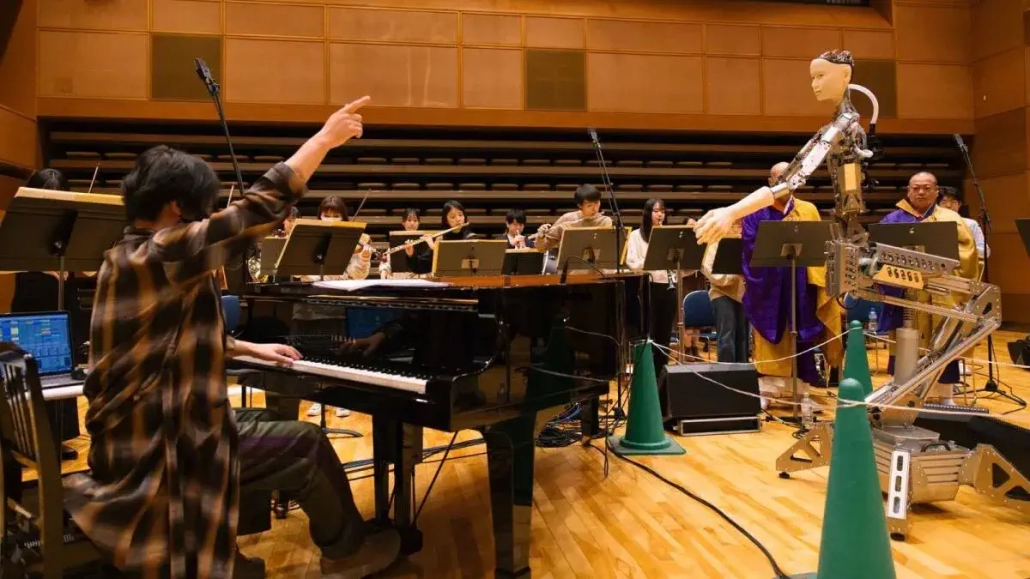

3. Armar-6: La maravilla tecnológica del Instituto de Tecnología de Karlsruhe
ARMAR-6, developed by the Karlsruhe Institute of Technology, is a cutting-edge humanoid robot designed specifically for industrial environments. This robot stands out for its ability to use tools and work collaboratively alongside human workers, representing a significant advancement in industrial robotics.The core strength of ARMAR-6 lies in its sophisticated AI technology, which enables it to perform a wide array of tasks, from object handling and grasping to complex maintenance work. This capability is crucial in industrial settings where precision and reliability are paramount. ARMAR-6's design incorporates advanced sensors and machine learning algorithms that allow it to understand and adapt to its environment, making it capable of performing tasks that were previously challenging for robots, such as delicate assembly work or machinery maintenance.Moreover, ARMAR-6 has been designed with human-robot collaboration in mind. It features safety mechanisms and user-friendly interfaces that enable seamless interaction with human workers, enhancing productivity and reducing the risk of injuries in the workplace. This collaboration is not just about working side by side; it's about integrating the robot into the workforce in a way that complements human skills and capabilities.ARMAR-6 represents a significant step towards the future of industrial robotics, where humanoid robots not only perform repetitive tasks but also bring value through their adaptability, precision, and ability to work in harmony with human workers. Its development signals a shift in how we think about robots in industrial settings, moving towards a future where they are integral partners in the manufacturing and maintenance processes.ring AI technology for object grasping and maintenance tasks, ARMAR-6 represents the practical applications of robots in the workforce.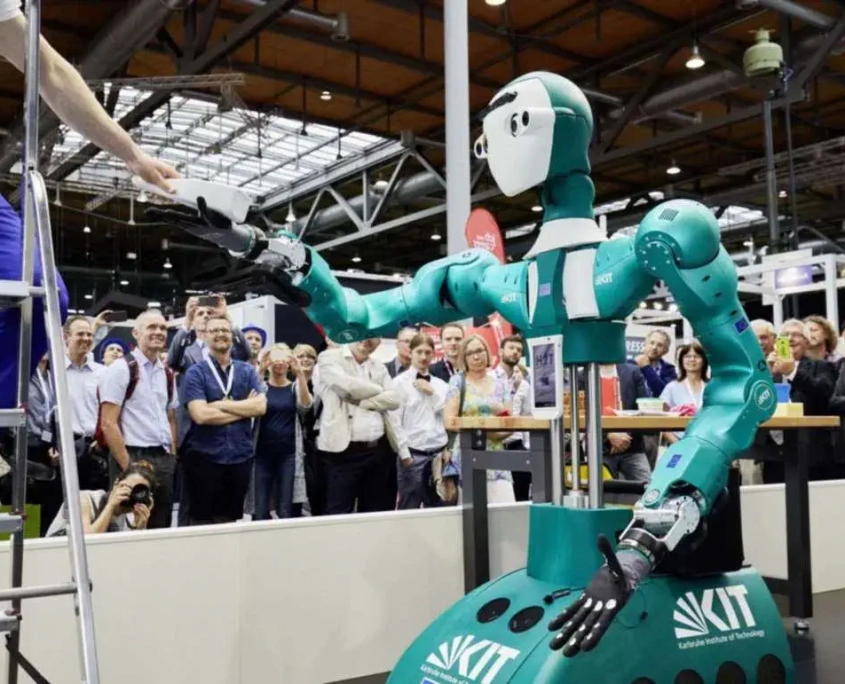
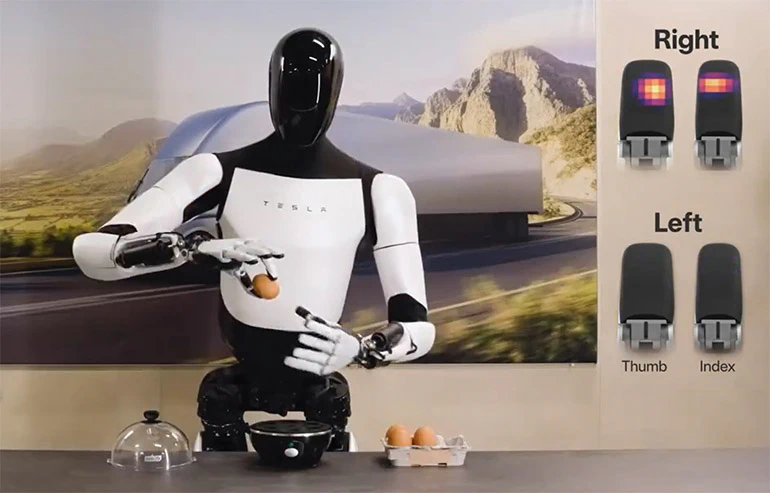

4. Optimus Gen2 de Tesla: Revolución de la robótica humanoide
The unveiling of Tesla's Optimus Gen2 humanoid robot on December 13 represents a groundbreaking moment in the field of robotics. This latest model from Tesla showcases substantial improvements over its predecessor, focusing on enhanced flexibility, weight reduction, and more human-like movements.Optimus Gen2 is a testament to Tesla's commitment to pushing the boundaries of robotic capabilities. It boasts life-like hand movements and a sophisticated design that enables it to perform tasks with precision akin to human dexterity. This level of precision is critical, especially for tasks that require a high degree of accuracy and finesse, marking a significant leap from the more mechanical movements typically associated with robots.In terms of mobility and balance, the Gen2 model shows remarkable improvements. Tesla reports a 30% increase in walking speed and a notable reduction in weight by 10 kg, enhancing the robot's agility and efficiency. These improvements make Optimus Gen2 more adaptable to a variety of tasks and environments.Elon Musk's vision for the Optimus Gen2 is ambitious, foreseeing its widespread use in Tesla's manufacturing processes and beyond. The potential applications of this robot are vast, ranging from replacing manual labor in dangerous or repetitive tasks to performing domestic chores. This aligns with Musk's broader vision of integrating advanced humanoid robots into everyday life, signifying a major development in the field of artificial general intelligence (AGI).Optimus Gen2's development indicates a future where humanoid robots could become common in various sectors, potentially transforming the way we work and interact with technology. Its advancements in weight, flexibility, and movement open up new possibilities for robotic applications, both in industrial settings and in daily life.
Actualización de octubre de 2024: Tesla Optimus presentó nuevas capacidades en el evento "WE, Robot"
On October 11, 2024, at the "We, Robot" event held at Warner Bros. Discovery Studio in Los Angeles, Tesla showcased new advancements and features of its Tesla Optimus humanoid robot. The highlight of the event was Elon Musk's announcement about the future pricing of Optimus, indicating that the Optimus Tesla price could be as low as $20,000 to $30,000 in the coming years. This significant price reduction is aimed at making the robot more accessible to both industrial and household customers, potentially transforming it into a mass-market product.During the event, the Tesla Optimus humanoid robot actively engaged with the audience, demonstrating new levels of social interaction and task automation. The robots were seen serving coffee, taking photos with attendees, and even performing group dances to showcase their refined movement capabilities. Tesla also unveiled a video showing Optimus performing household chores, such as retrieving packages from the porch, watering plants, and interacting with various home environments. This demonstration marked a clear step forward in Musk’s vision of integrating humanoid robots into everyday domestic settings.Elon Musk emphasized that the Optimus Tesla price would continue to drop as the production scale increases, driven by Tesla’s unique approach of integrating components from its existing electric vehicles. Key parts such as batteries, electronic systems, and AI modules are being shared across both its automotive and robotics divisions, significantly reducing manufacturing costs. According to Musk, Tesla plans to begin small-scale production of Optimus by early 2025, with the goal of deploying thousands of units in Tesla's factories by the end of that year. By 2026, the company aims to increase production dramatically and make the Tesla Optimus robot available to external customers, paving the way for widespread adoption.These updates indicate a major shift in the commercialization of humanoid robots. With its enhanced flexibility, agility, and affordability, Tesla Optimus is poised to redefine the robotics market. If Musk’s ambitious predictions hold true, Optimus could not only transform industries such as manufacturing and logistics but also find its way into homes, offering services from basic housekeeping to personalized interactions. This strategic development, along with the reduced Optimus Tesla price, solidifies Tesla's position as a leader in the rapidly evolving field of humanoid robotics.
5. Apolo: la avanzada creación humanoide de Apptronik
Apptronik's Apollo, following the footsteps of its predecessor Astro, is designed with a focus on enhancing efficiency in warehouse and plant operations. This humanoid robot is a powerhouse in material handling, capable of lifting and carrying items up to 55 pounds, which is a substantial load for robots of its kind.Apollo's design incorporates advanced technology that enables it to operate seamlessly in dynamic and busy environments. One of its key features is the impact zone detection technology, which allows Apollo to identify and react to moving objects and people around it. This feature is crucial for safety in environments where human-robot interaction is frequent.Another standout aspect of Apollo is its swappable battery system. This feature ensures continuous operation without significant downtime for charging, a critical factor in maintaining productivity in industrial settings. The swappable batteries allow for quick replacement, keeping Apollo operational around the clock if necessary.Designed with versatility in mind, Apollo can adapt to various tasks within warehouse and plant settings, from order picking to material transport. Its ability to carry substantial weight, coupled with its navigational and safety features, makes it an invaluable asset in these environments.Furthermore, Apollo represents the growing trend of using humanoid robots for more than just repetitive tasks. Its design caters to the need for robots that can work alongside humans, enhancing efficiency while maintaining safety standards. As we move forward, the capabilities of robots like Apollo are expected to expand, playing a significant role in the future of logistics and manufacturing operations.
6. Beomni por más allá de la imaginación: redefinir la interacción humano-robot
Beomni, una creación innovadora de más allá de la imaginación, está redefiniendo las capacidades de los robots humanoides controlados remotamente. Operado a través de auriculares VR y wearables, Beomni integra perfectamente la IA para aprender y ejecutar una variedad de tareas. Su objetivo principal es revolucionar la atención de los ancianos, brindando asistencia y compañía con un toque humano. Además, Beomni está diseñado para manejar trabajos tediosos y repetitivos en varias industrias, mostrando su versatilidad. Lo que distingue a Beomni es su potencial para crear una experiencia laboral remota más interactiva e inmersiva. Esto es particularmente relevante en el sector de la salud, donde el robot puede realizar tareas que generalmente requieren la presencia humana, como la atención y el monitoreo del paciente, ofreciendo así una nueva dimensión a los servicios de telesalud. El sistema de control avanzado de Beomni, combinado con AI, le permite realizar tareas complejas con precisión, lo que lo convierte en un activo valioso en escenarios en los que se necesita experiencia humana, pero la presencia física es un desafío. A medida que avanzamos, Beomni podría desempeñar un papel crucial en la transformación de cómo abordamos la asistencia remota, particularmente en la atención médica y el cuidado de ancianos, ofreciendo una combinación de empatía humana y eficiencia robótica.
7. Atlas: logro robótico de Boston Dynamics
Atlas, developed by the renowned robotics company Boston Dynamics, stands as a pinnacle of achievement in humanoid robotics. This robot is known for its extraordinary agility and mobility, capable of moving at speeds over 5 miles per hour and performing complex maneuvers such as backflips. What makes Atlas a marvel in robotics is its intricate blend of hardware and software: it is equipped with depth sensors, 28 hydraulic joints, and three onboard computers, enabling it to exhibit human-like agility and balance.Atlas serves primarily as a research and development tool, providing valuable insights into the possibilities of humanoid movement and balance. Its advanced design allows it to navigate complex terrains and perform tasks that require a high degree of coordination and physical ability. The technology behind Atlas includes state-of-the-art motion control systems and real-time environmental adaptation algorithms, making it capable of handling unpredictable and challenging scenarios.The potential applications of Atlas extend beyond research; it could be utilized in scenarios where human safety is at risk, such as search and rescue operations, disaster response, and other high-risk environments. Its ability to move quickly, jump over obstacles, and maintain balance in uneven terrain makes it an ideal candidate for tasks that are too dangerous or inaccessible for humans.Atlas’ development signifies a significant leap in robotics, pushing the boundaries of what humanoid robots can achieve in terms of movement and interaction with their environment. As technology progresses, Atlas could pave the way for the development of more advanced humanoid robots, capable of assisting humans in a variety of challenging and dynamic settings.
8. Digit: Innovación en movimiento de Agility Robotics
Digit, a highly innovative creation from Agility Robotics, is tailored for logistics and package handling tasks. This humanoid robot excels in environments such as unloading trailers and moving packages, showcasing a blend of advanced robotics and practical utility. Digit features fully functioning limbs capable of executing complex movements like crouching and squatting, adjusting its center of gravity as needed for various tasks.One of the key technologies in Digit is its surface plane-reading sensors. These sensors enable Digit to effectively navigate through environments, ensuring efficient pathfinding and avoiding obstacles. This capability is crucial in logistics environments where the robot needs to maneuver around tight spaces and handle packages of varying sizes and weights.Digit's design focuses on optimizing the efficiency of package handling processes. Its ability to adjust its center of gravity allows for safely carrying and moving heavy loads, which is a game-changer in warehouse settings. Digit's development represents an important step towards automating tasks in the logistics industry, potentially reducing labor costs and increasing efficiency in package sorting and handling.Moreover, Digit’s humanoid form allows it to seamlessly integrate into environments designed for human workers, reducing the need for extensive modifications to existing infrastructure. As the demand for faster and more efficient package handling grows, Digit stands out as a solution that combines the adaptability and dexterity of human workers with the efficiency and endurance of robotic technology.
9. Jiajia: la Universidad de Ciencias y la Tecnología de China Wonder Wonder
Jiajia is an exceptional humanoid robot developed by the University of Science and Technology of China. It represents a significant milestone in humanoid robotics with its human-like appearance and interactive capabilities. Designed with features modeled after real students, Jiajia breaks new ground in the field of humanoid robotics by focusing on lifelike interaction and communication.Jiajia's development centers on creating a robot that can engage in naturalistic and interactive communication, making it a potential game-changer in customer service, education, and as a social companion. With its realistic appearance, including lifelike skin and hair, Jiajia can mimic human facial expressions and engage in conversations with a level of realism that is unprecedented in Chinese robotics.The interactive capabilities of Jiajia are not just limited to basic communication. The robot is equipped with advanced AI that allows it to understand and respond to complex human emotions and cues. This makes Jiajia particularly suitable for roles where empathetic and nuanced interaction is crucial, such as in elderly care or as a guide in public spaces.Jiajia's development reflects the growing trend in humanoid robotics to create machines that not only perform tasks but also interact and communicate in a manner that is indistinguishable from humans. As technology advances, Jiajia could play an increasingly significant role in various sectors, offering a glimpse into a future where robots and humans coexist and interact seamlessly.

10. Erica: Un vistazo al futuro de Hiroshi Ishiguro Laboratories
ERICA, developed by Hiroshi Ishiguro Laboratories in Japan, stands as a testament to the advanced capabilities of humanoid robots in simulating human-like interaction. Known for her highly realistic appearance and sophisticated conversational abilities, ERICA sets a new standard in the field of humanoid robotics.ERICA's design goes beyond mere physical resemblance to humans. She is equipped with features that enable natural facial expressions and voice intonation, closely mirroring human communication nuances. This level of sophistication in ERICA's design allows her to engage in conversations that feel remarkably lifelike and intuitive.The technology behind ERICA includes cutting-edge AI algorithms that enable her to process and respond to visual, emotional, and conversational data. This makes ERICA not just a robot but a highly interactive platform that can be used in various settings where human-like interaction is valued, such as customer service, therapy, and educational roles.One of the unique aspects of ERICA is her ability to simulate empathy and emotional intelligence, making her interactions with humans more engaging and meaningful. This feature positions ERICA as a potential companion in healthcare settings, where she can provide comfort and assistance to patients, or in educational environments where she can offer personalized learning experiences.ERICA's development is a significant leap forward in human-robot interaction, showcasing the potential of humanoid robots to not only perform tasks but also to connect and communicate with humans on a deeper level. As humanoid robotics continue to evolve, ERICA represents a glimpse into a future where robots are an integral part of our social and professional lives.11. Kime: el humanoide de vanguardia de Macco Robotics
KIME, developed by Macco Robotics, is a unique addition to the world of humanoid robots, specializing in the hospitality industry. As a robotic bartender, KIME is designed to efficiently serve a variety of items, showcasing the potential of humanoid robots in customer service and hospitality settings.What sets KIME apart is its integration of advanced technologies to enhance the customer experience. It features a user-friendly touchscreen for ordering, a built-in payment system, and the capability to recognize regular customers. This level of personalization and automation makes KIME not just a novelty but a functional asset in bars and restaurants, capable of handling high-volume service with consistency and efficiency.KIME's ability to mix and serve drinks, coupled with customer recognition, illustrates the growing trend of humanoid robots being used to augment human capabilities in service industries. The robot's design focuses on creating an engaging interaction with customers, making it a point of attraction in any establishment.Moreover, KIME's application in the hospitality sector is an example of how humanoid robots can be tailored to specific industry needs. Its success in efficiently serving customers and managing transactions hints at broader implications for the use of humanoid robots in various service-oriented businesses, including retail, tourism, and event management.The development and deployment of KIME mark an exciting advancement in the field of humanoid robotics, demonstrating how these machines can be specialized to improve service delivery and customer experience in the hospitality industry.
12. Nadine: robot humano de la Universidad Tecnológica de Nanyang
Nadine, developed at Nanyang Technological University, is a remarkable social humanoid robot with advanced interactive capabilities. She features lifelike skin, hair, and upper body movements, making her one of the most realistic humanoid robots in terms of appearance. Nadine's design allows her to engage in natural human-like interactions, which is crucial for her roles in customer service and elder care.One of the key aspects of Nadine is her ability to recognize faces, speech, gestures, and objects. This makes her exceptionally well-suited for social interactions in various settings. In customer service, Nadine can provide personalized assistance, responding to individual needs and preferences of customers. In elder care, her realistic appearance and interactive capabilities enable her to provide companionship and support, helping to improve the quality of life for seniors.Nadine's development represents a significant advancement in humanoid robotics, particularly in creating robots that can seamlessly integrate into social environments. Her ability to process and respond to complex human cues and emotions opens up possibilities for humanoid robots to serve in roles that require empathy, understanding, and social interaction.As technology progresses, Nadine's applications could expand to include more diverse social roles, such as in education, healthcare, and hospitality. Her development underscores the potential of humanoid robots to not just perform tasks but also to connect and engage with humans on a social and emotional level. Nadine is a glimpse into a future where humanoid robots could become an integral part of our social fabric, enhancing human interactions in various sectors.
13. Nao: un fenómeno de robótica de SoftBank
NAO, developed by SoftBank Robotics, is a versatile humanoid assistant widely used in healthcare, education, and research. Standing as a testament to the advancements in humanoid robotics, NAO has become a popular figure in these sectors due to its interactive capabilities and user-friendly design.In healthcare, NAO serves as a supportive assistant, helping with therapeutic and educational activities. It's particularly effective in working with children, using its engaging and approachable design to assist in various therapies and learning activities. In educational settings, NAO is used as an interactive tool for teaching programming, languages, and other subjects, making learning more engaging and interactive.NAO is equipped with object recognition technology, directional microphones, speakers, and touch sensors, enhancing its interaction capabilities. It can speak up to 20 languages, which makes it an excellent tool for language learning and international educational programs.The robot's popularity in educational and healthcare settings is due to its ability to engage and interact with people in a manner that is both entertaining and educational. NAO's design and technology make it an ideal platform for introducing robotics and AI concepts to students and for providing companionship and assistance in healthcare environments.SoftBank Robotics' NAO is a shining example of how humanoid robots can positively impact various sectors. It demonstrates the potential of robotics in enhancing education, providing therapeutic support, and aiding in research and development in various fields. As technology advances, NAO's applications could expand, making it an even more invaluable tool in education, healthcare, and beyond.
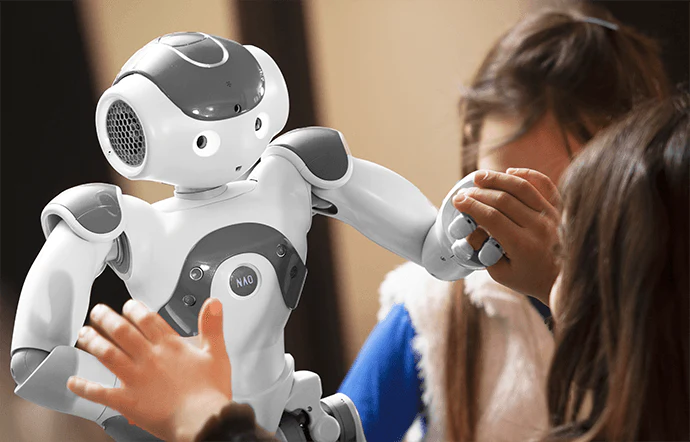
14. Oceanone de Stanford Robotics Lab: The Underwater Explorer
OceanOne, developed by Stanford Robotics Lab, represents a groundbreaking achievement in the field of underwater exploration and robotics. This diving robot is specifically designed to explore and operate in deep-sea environments, reaching depths that are often inaccessible or too dangerous for human divers.OceanOneK, the latest version of OceanOne, is equipped with advanced AI and haptic feedback systems, allowing it to handle a variety of underwater tasks with precision and sensitivity. This includes operating tools and equipment in challenging underwater conditions, making it an invaluable asset for scientific research, archaeological exploration, and deep-sea resource extraction.One of the most significant capabilities of OceanOne is its ability to provide haptic feedback to its operators. This feature allows users to feel what the robot is touching, giving them a sense of presence and enabling more delicate and precise operations. Combined with AI, OceanOne can make autonomous decisions based on environmental data, enhancing its efficiency and reliability in underwater exploration.OceanOne's ability to dive to depths of up to 1,000 meters opens new frontiers in oceanic exploration. It can access areas previously unreachable, revealing hidden aspects of the underwater world and contributing valuable data for scientific research. This robot has the potential to transform our understanding of the deep sea, offering insights into marine biology, geology, and other ocean-related fields.OceanOne's development is a significant step towards safer and more efficient underwater exploration. It represents the future of robotics in challenging environments, showcasing how advanced technology can extend human capabilities and enable us to explore new frontiers.
15. Pepper: humanoide amigable de SoftBank Robotics
Pepper, another innovative humanoid robot from SoftBank Robotics, is designed to operate in various interactive roles, particularly in healthcare, education, and hospitality. This robot is known for its ability to recognize faces and track human emotions, making it an ideal companion in environments where engaging and personalized interaction is crucial.In the healthcare sector, Pepper is used to assist both patients and healthcare providers. Its empathetic AI allows it to interact with patients, providing companionship, entertainment, and assistance in navigational tasks within healthcare facilities. In educational settings, Pepper enhances learning experiences by interacting with students and assisting educators in delivering engaging content.One of Pepper's unique features is its emotion recognition capability. This allows Pepper to respond appropriately to the mood and behavior of individuals, making its interactions more personal and effective. This feature is particularly beneficial in customer service roles within the hospitality industry, where understanding and responding to guest needs is essential.Pepper's design is not only about functionality but also about creating a robot that is approachable and friendly. This makes Pepper a versatile robot that can be employed in various public settings, from retail stores to hotels, where enhancing customer experience is a priority.As technology continues to evolve, Pepper's roles are expected to expand, further integrating this humanoid robot into daily life and various industries. Pepper's development underscores the growing importance of humanoid robots in providing interactive and personalized services, and its success points to a future where robots like Pepper become commonplace in supporting and enhancing human activities.
16. Promobot: la cara del servicio al cliente de la nueva era
Promobot, developed by the company of the same name, is a highly customizable humanoid robot designed to function in various service-oriented industries, including hospitality and healthcare. It stands out for its ability to perform a range of tasks, from concierge services to medical assistance, showcasing the multifaceted utility of humanoid robots.In hospitality settings, Promobot can greet guests, provide information, and even assist in check-in processes, enhancing the overall customer experience with its interactive capabilities. It's equipped with advanced AI that allows it to engage in natural conversations, answer queries, and guide guests, making it a valuable asset in hotels, resorts, and other customer-focused environments.In the healthcare sector, Promobot can assist in various ways, such as guiding patients, providing information about medical procedures, and even helping in patient registration processes. Its design is conducive to healthcare environments, where it can navigate autonomously and interact with patients and staff in a friendly and informative manner.Promobot is also capable of integrating with security systems, adding an additional layer of functionality to its already versatile design. This feature makes it suitable for use in environments where security is a priority, such as corporate buildings or public facilities.With its adaptable design and ability to perform a range of tasks, Promobot is a prime example of how humanoid robots can enhance service delivery and customer interaction in various industries. Its development and growing presence in the market reflect the increasing demand for humanoid robots that can provide efficient, interactive, and versatile services.
17. Robonaut 2: La colaboración de la NASA y General Motors
Robonaut 2, a collaborative creation between NASA and General Motors, is a significant development in the field of humanoid robotics, specifically designed for space missions and industrial applications. As the first humanoid robot to be sent into space, Robonaut 2 marks a milestone in the evolution of robotics technology.Robonaut 2's design focuses on performing tasks that are either too dangerous or too tedious for astronauts. Its capabilities include handling a wide range of tools and interfaces designed for space missions. This makes it an invaluable asset aboard the International Space Station, where it can assist astronauts in both routine and complex tasks, contributing to research and maintenance efforts.In industrial settings, Robonaut 2's application extends to performing precise and repetitive tasks in manufacturing environments. Its dexterity and precision in handling tools and components make it suitable for assembly lines, where it can work alongside human workers to enhance productivity and safety.Robonaut 2 is equipped with advanced sensors, control systems, and dexterous hands, enabling it to perform delicate tasks with a high degree of precision. Its humanoid form allows it to use the same tools and workspaces designed for humans, reducing the need for specialized equipment.The development of Robonaut 2 represents an important step toward the future of collaborative robotics, where robots and humans work together to achieve goals that would be challenging to accomplish independently. Its success in both space and industrial environments showcases the versatility and potential of humanoid robots in various applications, from scientific research to manufacturing.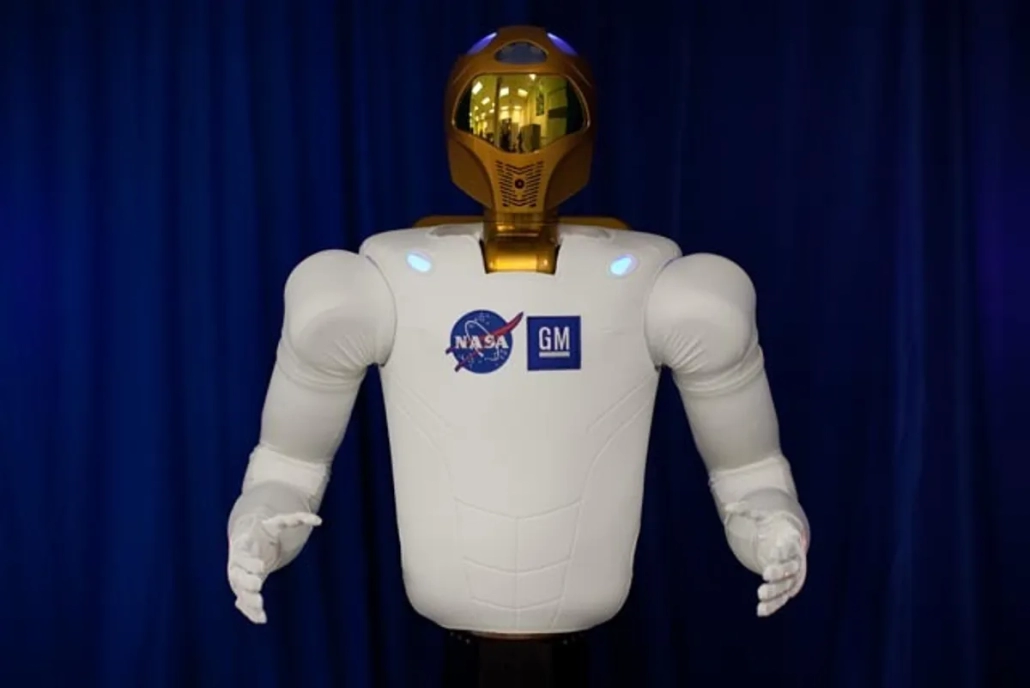

18. Gracia: Awakening Health Contribution a Robots de cuidado
Grace, a creation by Awakening Health in collaboration with Hanson Robotics and Singularity Studio, is a humanoid robot specifically designed for healthcare applications. She embodies a significant advancement in the field of humanoid robotics, with a focus on empathetic and interactive patient care.One of Grace's most notable features is her empathetic AI platform, which is capable of understanding and responding to patient needs in various healthcare environments. This advanced AI allows Grace to interact in a way that is not only informative but also comforting to patients, making her an ideal companion in settings like hospitals and care homes.Grace is equipped with facial recognition technology and a thermal camera, enabling her to detect emotional states and physical symptoms in patients. This capability allows her to provide personalized care and support, adapting her interactions based on the patient's condition and emotional state.Her role in healthcare extends beyond patient interaction. Grace can assist medical staff by providing patient information, reminding patients of medication schedules, and even helping in monitoring patient health. Her presence in healthcare settings can enhance the overall patient experience, providing a sense of companionship and support that is crucial in medical care.Grace represents the growing importance of humanoid robots in healthcare, not just as tools for medical tasks, but as beings capable of providing empathy and support. Her development illustrates how advanced robotics and AI can be harnessed to improve patient care and assist healthcare professionals, showcasing a future where humanoid robots play a vital role in the medical field.
19. Robotespiano: una maravilla teatral de las artes de ingeniería
RoboThespian, developed by Engineered Arts, is a versatile and interactive humanoid robot designed primarily for entertainment and educational purposes. This robot stands out for its ability to perform in front of crowds and interact with people via telepresence software, making it an innovative tool in both the arts and education.One of RoboThespian's key attributes is its ability to express a wide range of micro-facial expressions and engage in direct eye contact, which creates a more lifelike and engaging interaction with audiences. This capability is especially valuable in educational settings, where RoboThespian can be used as a dynamic teaching aid, capable of captivating students’ attention and delivering content in an interactive manner.In entertainment settings, RoboThespian's performance abilities come to the fore. It can act, recite, sing, and even perform gestures and movements synchronized with audio-visual content. This makes RoboThespian not just a robot but a performer, capable of entertaining audiences in theaters, exhibitions, and events.The development of RoboThespian signifies a leap forward in humanoid robotics, showcasing the potential of robots not just as tools for tasks but as engaging and interactive figures in public spaces. RoboThespian’s adaptability and interactive capabilities make it a prime example of how humanoid robots can be integrated into diverse sectors, including arts, education, and public engagement.As technology advances, we can expect to see more robots like RoboThespian, which blend entertainment with interactivity, enhancing experiences in various public and educational settings.
20. Sophia: robot humanoide icónico de Hanson Robotics
Sophia, developed by Hanson Robotics, is one of the most iconic and recognizable humanoid robots in the world. Known for her advanced artificial intelligence and lifelike appearance, Sophia represents a significant breakthrough in humanoid robotics, especially in terms of naturalistic interaction and communication.Sophia is equipped with cutting-edge AI that allows her to process visual, emotional, and conversational data. This advanced technology enables Sophia to interact with humans in a highly realistic and engaging manner. She can recognize faces, maintain eye contact, understand and respond to questions, and exhibit a wide range of human-like expressions.What sets Sophia apart is her ability to engage in meaningful conversations, making her more than just a robotic figure. She can discuss various topics, express opinions, and even tell jokes, which has made her a popular figure in media appearances, interviews, and public speaking events. Sophia's interactive capabilities have been showcased in various international platforms, where she has engaged with politicians, celebrities, and industry leaders.Sophia’s design, including her realistic facial features and expressions, is based on Audrey Hepburn and Hanson Robotics’ founder's wife. This design choice was intended to make her appearance friendly and relatable, which helps in establishing a connection with human interactants.Sophia's development has significant implications for the future of humanoid robotics. She demonstrates the potential for robots to become part of social interactions and conversations, paving the way for future applications in various sectors, including customer service, healthcare, and education. Sophia’s existence challenges the traditional boundaries between humans and machines, opening up discussions about the future role of robots in society.
21. Surena IV: Innovación robótica de la Universidad de Teherán
Surena IV, developed at the University of Tehran, is a remarkable example of advancements in humanoid robotics. This robot exemplifies significant progress in mobility, manipulation, and interaction capabilities. Surena IV stands out for its ability to use tools effectively and navigate uneven terrain, showcasing the potential of humanoid robots in diverse and challenging environments.One of the key features of Surena IV is its improved hand design, which allows for more precise and dexterous movements. This capability is crucial for tasks that require a high degree of manipulation, such as handling delicate objects or performing tasks that require fine motor skills. The robot’s advanced tracking ability also enables it to interact more effectively with its environment and with people, making it suitable for various applications, from industrial tasks to assisting in daily activities.The development of Surena IV focuses on enhancing humanoid robot mobility. The robot's ability to walk, climb stairs, and navigate uneven surfaces represents a significant technological achievement. This mobility is critical for applications in areas where the terrain or accessibility is challenging, such as in search and rescue missions or in assisting people with mobility impairments.Surena IV's advancements demonstrate the growing capabilities of humanoid robots in performing complex tasks and operating in diverse environments. The robot’s development reflects a broader trend in robotics towards creating machines that can work alongside humans, complementing human abilities and assisting in tasks that are difficult, dangerous, or tedious. Surena IV represents the future potential of humanoid robots in enhancing productivity, safety, and quality of life.
22. T-HR3: Robot humanoide de Toyota para un mañana mejor
The T-HR3, developed by Toyota, is a groundbreaking humanoid robot designed as a remote avatar, controlled by wearable devices. This robot represents Toyota's vision for the future of personal assistance and support, especially in healthcare and household environments.T-HR3's design focuses on mimicking the motions of its human operator, achieved through a sophisticated control system. This system allows the robot to replicate complex human movements with a high degree of accuracy, making it an effective tool for tasks that require precision and delicacy. The wearable control devices enable intuitive operation, allowing users to control the robot as an extension of their own body.One of the most significant applications of the T-HR3 is in healthcare, where it can assist with patient care and support medical professionals. Its ability to be remotely controlled means that healthcare providers can perform certain tasks or provide assistance from a distance, which is particularly valuable in situations where direct human contact may be risky, such as in infectious environments or remote medical services.In addition to healthcare, T-HR3 has potential applications in household settings. Its humanoid form and dexterity make it suitable for a range of domestic tasks, from assisting with household chores to providing support for elderly or disabled individuals. The robot's capability to be controlled remotely also offers the possibility of providing assistance and companionship to those who require it, regardless of the geographical distance.The development of T-HR3 showcases Toyota's commitment to leveraging robotics technology to enhance human life and well-being. It represents a significant step towards the integration of humanoid robots into daily life, offering a glimpse into a future where robots can provide practical and compassionate assistance in both healthcare and home environments.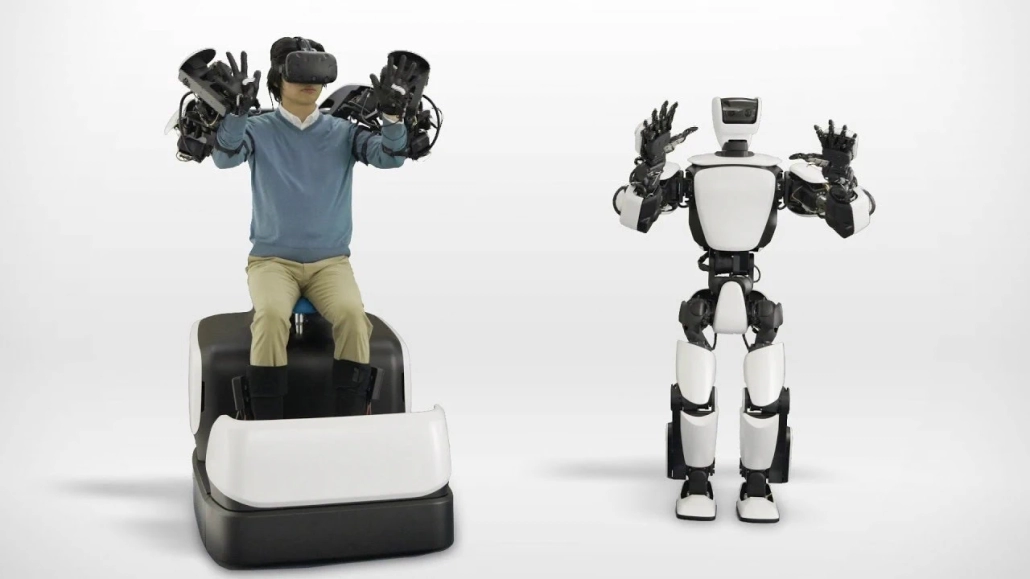

23. Walker X: el paso de Ubtech Robotics en avanzado robótica
Walker X, developed by UBTECH Robotics, is a highly advanced humanoid robot that showcases significant progress in balance, coordination, and mobility. Designed to operate in domestic settings, Walker X is capable of performing a variety of household tasks, making it an exemplary figure in the future of service robots.One of the key features of Walker X is its enhanced balance and hand-eye coordination. This enables the robot to navigate complex indoor environments, climb stairs, and handle objects with precision. Such capabilities are crucial for a robot designed to assist with daily tasks in a home environment, where adaptability and versatility are essential.Walker X's ability to perform household tasks is not limited to simple chores. It can assist with more complex activities like setting tables, helping with cooking, and even engaging in interactive games and activities. This versatility makes Walker X a valuable companion, especially for individuals who require assistance due to age, disability, or other reasons.In addition to its practical applications, Walker X represents a significant achievement in humanoid robotics. Its development reflects a growing trend in robotics towards creating machines that can seamlessly integrate into human environments and assist with everyday activities. The design and functionality of Walker X illustrate how robots can be more than just tools for specific tasks – they can be integrated members of our living spaces, enhancing quality of life and providing support where it's needed.As technology continues to advance, the potential applications for robots like Walker X are vast. They could transform the way we think about domestic assistance and personal care, offering solutions that combine efficiency, safety, and interactive companionship.
24. Phoenix: contribución de Sanctuary AI al mundo humanoide
Phoenix, created by Sanctuary AI, represents a significant advancement in the field of humanoid robotics. Designed for diverse workforce roles, Phoenix is equipped with human-like hands and AI training capabilities, demonstrating the adaptability and potential autonomy of humanoid robots in various industries.One of the standout features of Phoenix is its highly dexterous hands, which are capable of performing intricate tasks that require a high level of precision and finesse. This ability is crucial for roles that traditionally rely on the nuanced skills of human hands, such as assembling delicate components in manufacturing or performing intricate procedures in healthcare settings.In addition to its physical capabilities, Phoenix is also equipped with advanced AI that enables it to learn and improve tasks over time. This learning ability allows Phoenix to adapt to new challenges and environments, making it a versatile tool for businesses looking to integrate robotic technology into their operations.Phoenix's design is focused not only on task execution but also on working collaboratively with human colleagues. Its ability to learn from and adapt to human interactions is a key factor in its potential for widespread adoption in the workforce. This collaborative approach is particularly important in industries where teamwork and adaptability are crucial, such as healthcare, manufacturing, and customer service.The development of Phoenix by Sanctuary AI highlights the growing trend towards creating humanoid robots that can seamlessly integrate into and enhance human work environments. As technology continues to evolve, Phoenix and similar robots are expected to play increasingly significant roles in various sectors, offering solutions that combine human-like dexterity, AI-driven adaptability, and collaborative potential.
25. Eva: la visión de 1x de la compañera de mañana
EVE, developed by 1X, is an AI-powered humanoid robot that is making significant strides in the workforce. Designed with strong grippers, panoramic vision cameras, and wheeled mobility, EVE showcases the integration of advanced robotics and AI to learn and improve tasks, demonstrating potential applications in retail, logistics, and security.EVE's strong grippers are a key feature, enabling it to handle a variety of objects, which is particularly useful in logistics for tasks like sorting and transporting goods. Its panoramic vision cameras provide a comprehensive view of its surroundings, allowing for accurate navigation and task execution in complex environments.The wheeled mobility of EVE gives it an edge in terms of movement and speed, making it well-suited for tasks that require quick and efficient navigation, such as patrolling in security settings or moving through large warehouses. The integration of AI allows EVE to learn from its experiences, continuously improving its efficiency and effectiveness in various tasks.In retail environments, EVE can be utilized for stock management, customer assistance, and even as an interactive information point. Its ability to recognize and interact with customers adds a new dimension to the retail experience, blending efficiency with a personal touch.EVE represents a significant advancement in the field of humanoid robotics, with its combination of physical dexterity, advanced vision capabilities, and AI-driven learning. As the capabilities of robots like EVE continue to evolve, they are set to play an increasingly vital role in various industries, enhancing productivity, safety, and customer experience.

26. Asimo: robot humanoide pionero de Honda
ASIMO, developed by Honda, is one of the most well-known humanoid robots globally, recognized for its pioneering role in advanced robotics and AI integration. As one of the earliest humanoid robots, ASIMO has played a significant part in pushing the boundaries of what is possible in robotics.Known for its bipedal walking ability, ASIMO can run, climb stairs, and even dance, showcasing Honda's commitment to creating a robot that closely mimics human movement and balance. This ability to move in a manner similar to humans has made ASIMO a valuable platform for research and development in humanoid robotics.Over the years, ASIMO's development has contributed significantly to the field, with advancements in mobility, dexterity, and interaction. ASIMO's design includes features such as hand dexterity that allows it to perform tasks like opening a bottle or pouring a drink, and its ability to recognize faces and understand spoken commands.ASIMO’s development has provided valuable insights into how robots can assist in various settings, including helping people with mobility challenges and performing tasks in hazardous environments. Its friendly and approachable design has also made it an effective ambassador for robotics, helping to demystify technology and showcase the potential of robots to positively impact society.Honda’s work on ASIMO has laid a foundation for future developments in humanoid robotics. The learnings from ASIMO continue to influence the design and functionality of newer robots, driving the evolution of robots that are more adaptable, interactive, and capable of working alongside humans in various capacities.27. Figure 2 Humanoid Robot
Figure 2 Humanoid Robot is an advanced AI humanoid robot designed for a variety of complex environments, including industrial applications and human-robot interactions. This new humanoid robot combines cutting-edge robotics and artificial intelligence, making it one of the most promising humanoid robots in the market.Características clave:
- NVIDIA Humanoid Robot Platform: Figure 2 uses NVIDIA's AI computing power, providing enhanced vision processing and real-time decision-making capabilities. This NVIDIA humanoid robot platform allows for more precise movements and improved adaptability in diverse situations.
- BMW Humanoid Robots Collaboration: The robot has been tested in collaboration with BMW humanoid robots to optimize its efficiency in manufacturing and logistics. Its agility and ability to handle complex assembly tasks make it a viable option for the humanoid robot market.
- Futuristic Humanoid Robot Design: Figure 2’s design emphasizes a sleek, futuristic humanoid robot appearance with a fully articulated frame, allowing for fluid motion and dexterity. It also includes a humanoid robotic arm that can grasp objects with human-like precision, making it a valuable tool in environments requiring delicate handling.
- Apariencia humanoide realista: La apariencia del robot y el movimiento de fluido imitan de cerca las acciones humanas, posicionándolo como uno de los robots humanoides más realistas disponibles. Este enfoque de diseño tiene como objetivo cerrar la brecha entre la colaboración humana y robot, lo que facilita que los humanos interactúen y confíen en el robot en varios entornos.
- Robot humanoide para la venta en 2024: Con su lanzamiento esperado en 2024, la Figura 2 está configurada para competir como uno de los mejores robots humanoides para uso industrial y personal. Su compilación modular y su software personalizable lo hacen adecuado para diferentes aplicaciones, desde la automatización de almacenes hasta configuraciones educativas.
Aplicaciones:
- Automatización Industrial: La Figura 2 puede realizar tareas que generalmente son manejadas por robots que reemplazan a los humanos en entornos de trabajo peligrosos o repetitivos. Su plataforma impulsada por la IA le permite ajustarse a las condiciones cambiantes, reduciendo la necesidad de intervención humana.
- Colaboración humana-robot: Este robot está diseñado para trabajar junto a humanos en espacios compartidos, mostrando el potencial para que los humanos y los robots trabajen juntos sin problemas. Su forma humana y su capacidad para responder a los comandos de voz lo convierten en una adición única al creciente campo de los robots que ayudan a los humanos.
Robot Humanoide Isaac: una nueva generación de innovación con IA
El robot Isaac es un robot humanoide AI de vanguardia que representa el siguiente paso en la robótica humanoide. Diseñado con un enfoque en la interacción humana y la integración perfecta en varios entornos, Isaac se destaca como uno de los robots humanoides más avanzados del mercado hoy en día. Este nuevo robot humanoide combina inteligencia artificial, actuadores de alto rendimiento y un diseño sofisticado para lograr movimiento e interacciones realistas.Características clave del robot humanoide Isaac:
- Plataforma de IA avanzada: Isaac se basa en una plataforma de robot humanoide Nvidia, aprovechando el poder de la IA para procesar datos complejos, reconocer las emociones humanas y responder en tiempo real. Esta tecnología de IA avanzada permite a Isaac interactuar con las personas de forma natural, lo que lo convierte en una opción ideal para entornos donde la colaboración humana-robot es esencial.
- Diseño humanoide realista: La cara del robot humanoide y la estructura corporal de Isaac están meticulosamente elaboradas para parecer acogedor y no amenazante, lo cual es crucial para generar confianza en entornos como el servicio al cliente, la salud y la educación. Su apariencia se parece mucho a un humano, lo que lo convierte en uno de los robots humanoides más realistas disponibles en el mercado.
- Personalizable y adaptable: El diseño modular de ISAAC permite una fácil personalización basada en necesidades específicas. Ya sea equipado con armas robóticas humanoide adicionales para tareas delicadas o actualizadas con el último software de IA, Isaac puede adaptarse a varios roles, lo que lo convierte en un contendiente principal entre los mejores robots humanoides para uso industrial y comercial.
- Movimiento humano: Este robot humanoide futurista está diseñado para moverse con gracia y precisión. Utilizando los actuadores de robot humanoides de última generación, Isaac puede caminar, correr e incluso realizar acciones complejas como levantar objetos o navegar a través de terrenos desafiantes. Este movimiento realista posiciona a Isaac como líder entre los robots humanoides con inteligencia artificial.
- Construido para la colaboración: Una de las características destacadas de Isaac es su capacidad para trabajar junto a los humanos de manera segura. Con sensores integrados y un sistema de visión avanzado, ISAAC puede navegar en espacios llenos de gente y ayudar en tareas repetitivas o peligrosas, funcionando efectivamente como uno de los robots que ayuda a los humanos tanto en los lugares de trabajo como en los entornos públicos.
Aplicaciones del robot Isaac:
- Servicio al Cliente: ISAAC está siendo adoptado por varias industrias para su uso como robot humanoide orientado al cliente en el comercio minorista, la hospitalidad y la atención médica. Su capacidad para participar en conversaciones significativas lo convierte en un activo valioso para mejorar la experiencia del cliente.
- Cuidado de la salud: Con su capacidad para monitorear a los pacientes y proporcionar compañía, Isaac se está haciendo un nombre en entornos de salud, ofreciendo apoyo emocional y asistencia funcional.
- Educación: Las capacidades interactivas y el procesamiento del lenguaje natural de ISAAC permiten ser utilizado como asistente de enseñanza, lo que hace que el aprendizaje sea más atractivo para los estudiantes.
Futuro de la robótica humanoide:
La Figura 2 representa un paso adelante significativo en el desarrollo deRobots humanoide realesEso puede realizar tareas complejas mientras se mantiene una presencia humana. Como elMercado de robots humanoidesSe expande, se espera que la Figura 2 juegue un papel crucial en la configuración del futuro de la robótica, particularmente en los sectores que requieren habilidades físicas y cognitivas. Al integrar la IA avanzada, el diseño sofisticado y las pruebas del mundo real, la Figura 2 se convertirá en un punto de referencia para la próxima generación de la próxima generación de la próxima generación deRobots humanoides en Chinay en todo el mundo. Su desarrollo subraya la rápida evolución deRobots humanoides con inteligencia artificialy su creciente papel en el lugar de trabajo moderno.Tendencias y predicciones en el mercado de robots humanoides
El mercado de robótica humanoide actualmente está montando una ola de crecimiento excepcional. Se proyecta que el mercado, valorado en $ 1.6 mil millones en 2022, se dispare a un asombroso $ 214.4 mil millones para 2032. Este crecimiento significativo es impulsado por un apetito creciente para los robots humanoides en varios sectores, incluida la asistencia personal, el entretenimiento, la educación y el cuidado de la salud.Impulsores clave del crecimiento del mercado- Aplicaciones diversas: La versatilidad de los robots humanoides, capaces de tareas que van desde la asistencia doméstica hasta la participación en procedimientos médicos complejos, es un factor importante que impulsa su demanda.
- Avances en IA: La evolución de la inteligencia artificial ha sido fundamental para mejorar las capacidades de los robots humanoides, haciéndolos más eficientes, interactivos y adaptables.
- Mayor automatización: A medida que las industrias avanzan hacia la automatización, los robots humanoides se consideran soluciones viables para tareas que requieren un nivel de destreza y toma de decisiones previamente excluyentes para los humanos.
Revelando el futuro: el mundo progresivo de los robots humanoides
La industria de la robótica humanoide, a pesar de enfrentar desafíos considerables durante la pandemia de Covid-19, como las interrupciones de la cadena de suministro y la escasez de mano de obra, ha demostrado una resiliencia extraordinaria. El sector ha adaptado sus procesos de fabricación y sus flujos de ingresos sostenidos, mostrando una trayectoria prometedora para el futuro de la robótica.Adaptarse a los desafíos para el crecimiento continuoLas compañías de robótica han adoptado enfoques estratégicos para superar estos desafíos y garantizar el crecimiento. La diversificación de proveedores, el cultivo de relaciones sólidas e implementación de la fabricación justo a tiempo ha sido crucial. Además, adoptar el trabajo remoto, aumentar la fuerza laboral y aprovechar la automatización se han convertido en estrategias indispensables para el éxito. El monitoreo de los riesgos, el mantenimiento de las existencias de amortiguación, el fomento de la innovación y las redes de la industria también son fundamentales para mantenerse competitivos en este mercado en evolución.Tendencias emergentes en la atención médica y las aplicaciones comercialesMirando hacia el futuro, el sector de la salud se destaca como un área clave para la implementación del robot humanoide. Desde los roles de seguridad y la dispensación farmacéutica hasta la asistencia del paciente, los robots humanoides están listos para revolucionar los servicios de salud. Globalmente, los robots humanoides están avanzando en aplicaciones comerciales como patrulla, logística y almacenamiento. Eve by 1x Technologies es un ejemplo de implementación exitosa en la patrulla de seguridad, mientras que Digit se centra en la logística y el almacenamiento, con el objetivo de un lanzamiento completo del mercado para 2025.Políticas de apoyo e inversiones que impulsan el crecimientoCon políticas de apoyo, inversión de capital y avances tecnológicos, el potencial de los robots humanoides solo se expandirá. Sus futuras aplicaciones comerciales probablemente se extenderán a las industrias de servicios y manufacturas. La visión de Elon Musk para el robot humanoide de Tesla incluye tareas familiares cotidianas como la cocina y el mantenimiento del césped. Para 2025, se anticipa que los robots humanoides harán un incursión significativo en la fabricación, especialmente en sectores como la electrónica y el automóvil. Se espera que el valor de un informe de mayo de 2023 por GGII, la penetración del mercado global de robots humanoides en el sector de servicios, se espera que alcance el 3.5% para 2026, con un tamaño de mercado que supere los $ 2 mil millones. Para 2030, se prevé que el mercado global de robots humanoides supere los $ 20 mil millones, con el mercado de China que se espera que alcance los $ 5 mil millones, que comprende alrededor del 25% del mercado global. En conclusión, el futuro de la robótica, particularmente los robots humanoides, está marcado por un crecimiento dinámico, aplicaciones innovadoras y un impacto transformador en varias industrias. A medida que analizamos más en los futuros de los robots, la siguiente sección explorará casos de uso específicos y los avances tecnológicos que impulsan esta emocionante evolución.La potencia detrás de los robots humanoides: avances en la tecnología de la batería
En el intrincado mundo de los robots humanoides, la elección de la batería es un aspecto crítico que afecta directamente su funcionalidad, eficiencia y seguridad operativa. El derechobatería de robotNo solo garantiza un rendimiento óptimo, sino que también extiende la vida útil y la confiabilidad de estas máquinas sofisticadas.1. Tipos clave de baterías de robots
- Baterías de iones de litio (Li-ion): Comúnmente utilizados en varias aplicaciones robóticas, las baterías de iones de litio ofrecen una alta densidad de energía, lo que significa que pueden almacenar más energía en un espacio más pequeño. Esto los hace ideales para robots humanoides donde el tamaño y el peso son factores críticos.
- Baterías de polímero de litio (lipo): Las baterías LIPO son conocidas por su flexibilidad en términos de forma y tamaño, y proporcionan una mayor relación potencia / peso. Su naturaleza liviana es particularmente beneficiosa para los robots humanoides que requieren movilidad y agilidad.
- Baterías de fosfato de hierro de litio (Lifepo4): Entre los diversos tipos de baterías, las baterías de litio LifePO4 se prefieren cada vez más en los robots humanoides. Estas baterías ofrecen ventajas significativas en términos de seguridad, ya que son más estables y menos propensos al sobrecalentamiento. También tienen una vida útil más larga y pueden soportar un mayor número de ciclos de carga, lo que los convierte en una opción rentable y confiable para el uso a largo plazo en robótica.
2. Ventajas de las baterías de litio de Lifepo4 en robótica
Las baterías de litio LIFEPO4 se destacan en el ámbito de las baterías de robotes debido a sus características únicas:- Seguridad: Son inherentemente más seguros con un menor riesgo de fugitivo térmico, que es crucial cuando los robots interactúan muy cerca de los humanos.
- Longevidad: Estas baterías ofrecen ciclos de vida más largos, reduciendo la frecuencia de los reemplazos y el mantenimiento.
- Estabilidad: Las baterías LIFEPO4 mantienen un rendimiento constante en una amplia gama de temperaturas y condiciones de funcionamiento, esencial para los robots que funcionan en entornos variados.

